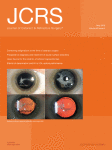
JCRS May 2019
Eyes with shallow anterior chambers present challenges to the cataract surgeon. A prospective randomised clinical study compared intraoperative performance and postoperative outcomes between femtosecond laser-assisted cataract surgery (FLACS) and conventional phacoemulsification in eyes with shallow anterior chambers. The study randomised 182 cataract surgery patients who were followed up at one day, one week, and at one, three and six months. The cumulative dissipative energy was significantly lower in the FLACS group. Patients undergoing FLACS maintained clearer corneas, showed less increase in central corneal thickness, lower anterior chamber inflammation and better uncorrected distance vision in the early postoperative period.
VK. Sharma et al., “Comparative evaluation of femtosecond laser-assisted cataract surgery and conventional phacoemulsification in eyes with a shallow anterior chamber”, Vol. 45, Issue 5, pp 547-552.
IOL calculation in keratoconus patients
A recent study compared the refractive accuracy of different formulas for intraocular lens power calculation in 41 eyes with keratoconus. The investigators measured preoperative keratometry, anterior chamber depth and axial length with optical biometry. IOL power formulas included the Barrett Universal II, Haigis, Hoffer Q, Holladay 1 and SRK/T formulas. Subjective refraction was assessed at one month. The mean prediction error, median absolute error and percentage of eyes within ±0.50 dioptres (D), ±0.75D and ±1.00D were calculated. All formulas led to hyperopic refractive outcomes. The SRK/T was the most accurate formula. The results were worse in advanced stages of the disease. The researchers note that the SRK/T formula tends to overestimate IOL power in eyes with steep corneas, which could be useful in patients with keratoconus.
G. Savini et al., “Intraocular lens power calculation in eyes with keratoconus”, Vol. 45, Issue 5, pp 576-581.
Trifocal comparison
Is there an IOL that can provide good near, middle and distance vision? A prospective case series compared outcomes in 160 patients who had bilateral phacoemulsification and implantation of a trifocal AcrySof IQ PanOptix, AT LISA tri 3M, FineVision or the bifocal Tecnis ZLB00 IOL. By six months postoperatively, there were no statistically significant between-group differences in the spherical equivalent, UDVA, CDVA, DCNVA, reading performance or CSF under photopic and mesopic conditions. The defocus curves at 100%, 50%, and 15% of contrast showed that trifocal IOLs, especially the AcrySof PanOptix, had better intermediate performance than the bifocal IOL and comparable outcomes at far and near distances. There were no statistically significant differences in the postoperative NEI VFQ-25 questionnaire scores between the four IOL groups.
A. Martínez de Carneros-Llorente et al., “Comparison of visual quality and subjective outcomes among 3 trifocal intraocular lenses and 1 bifocal intraocular lens”, Vol. 45, Issue 5, pp 587-594.

 JCRS May 2019
JCRS May 2019